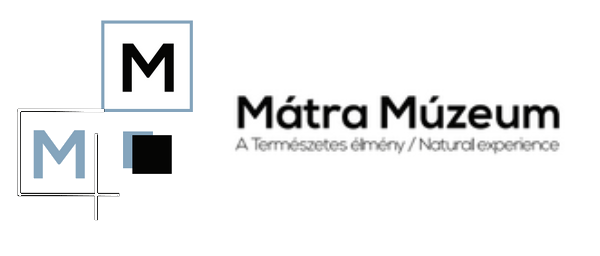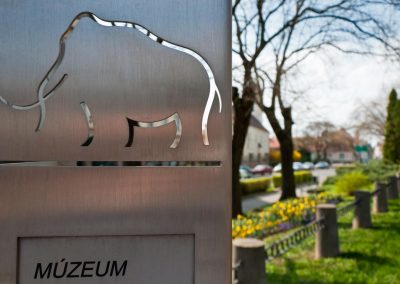Presentation of the Project
THE PROJECT
Mátra Museum of the Hungarian Natural History Museum is located in Gyöngyös, by Road no. 24 leading to Mátra. The former Orczy Castle, with its garden of nearly 2 hectares, acquired its current, classical form in the middle of the nineteenth century. From 1957, the institution with natural science, historical, archaeological and ethnographic collections began to operate here. Until the end of the 20th century, visitors of Gyöngyös could see its exhibitions here, including also the famous mammoth skeleton discovered in Mátraderecske.
During the renovations started in 2000, first the castle building was inaugurated. The outstanding quality of the reconstruction was recognized with the Europa Nostra Award in value preservation category on 5 June, 2009. At that time, however, not only the castle was renovated but the exhibition spaces were expanded with the three-storey natural science pavilion opened in 2009 and erected on the site of the former greenhouse, and the conditions for museum pedagogical education were created, as well. With its valuable vegetation, where the typical plants of the area can be viewed by the visitors, the 2-hectare garden is also an active display space. Visitors are awaited by a bird feeder and birdwatching hut equipped with cameras, a “wasp garage”, and a Mediterranean terrace. In 2010, the institution was awarded “The Museum of the Year” title for its full-scale museum development, and the museology and public educational work related to the exhibitions.
THE PROJECT
Mátra Museum of the Hungarian Natural History Museum is located in Gyöngyös, by Road no. 24 leading to Mátra. The former Orczy Castle, with its garden of nearly 2 hectares, acquired its current, classical form in the middle of the nineteenth century. From 1957, the institution with natural science, historical, archaeological and ethnographic collections began to operate here. Until the end of the 20th century, visitors of Gyöngyös could see its exhibitions here, including also the famous mammoth skeleton discovered in Mátraderecske.
During the renovations started in 2000, first the castle building was inaugurated. The outstanding quality of the reconstruction was recognized with the Europa Nostra Award in value preservation category on 5 June, 2009. At that time, however, not only the castle was renovated but the exhibition spaces were expanded with the three-storey natural science pavilion opened in 2009 and erected on the site of the former greenhouse, and the conditions for museum pedagogical education were created, as well. With its valuable vegetation, where the typical plants of the area can be viewed by the visitors, the 2-hectare garden is also an active display space. Visitors are awaited by a bird feeder and birdwatching hut equipped with cameras, a “wasp garage”, and a Mediterranean terrace. In 2010, the institution was awarded “The Museum of the Year” title for its full-scale museum development, and the museology and public educational work related to the exhibitions.
From the end of 2013, Mátra Museum has become subject to the management of the Hungarian Natural History Museum – it has become one of its member institutions with an independent operating license. The main profile of the institution is natural science, but its field of activities also includes the collection and processing of local history objects and documents, exploration of the local material, intellectual and built heritage, furthermore, the organization and arrangement of complex natural science and local history-related museum pedagogical programs. The basis for the public educational activities of the institution is constituted by the permanent and temporary exhibitions built on natural science collections. The museum pedagogical and public educational programs developed for them are recognized and very popular. Each year about 5,000 students attend our classes. Thanks to our exhibition and goal-specific events, beyond learning about natural environment, we would like to achieve attitude formation, as well, which can be realized by us in a demanding museum environment.
A part of this is the currently opening experience space during the project titled EFOP 3.3.6-17 “Knowledge from Experience – Naturally in Mátra Museum!”. The four floor halls of the Orczy Castle, which had once hosted the permanent exhibition of mineralogy and palaentology, have been transformed into a state-of-the-art multimedia experience centre furnished with audio-visual equipment, where countless interesting and scientific specialties await not only adult but also the youngest museum visitors. They can learn about terrestrial and aquatic life, the depth of the Miocene sea or the causes and processes of volcano formation. They can visit the “bottom” of a mine where they can explore the geological values and mineral resources of Mátra. They can get an insight into the nature-shaping activities of man, get an idea how the Carpathian Basin’s present image has evolved and how climate change affects wildlife and the natural environment.
Our goal is to ensure that the primary and secondary school students who attend classes can become young people who recognize natural values, who will be receptive to natural science, so they will prefer the fields of science or engineering when choosing a career, become environmentally conscious adults, who are able to pass on their knowledge and attitudes to later generations.
The implementation period of the project will last from 1 January, 2018 to 31.12.2020 + 2 years of maintenance period. The classes begin on 1 February, 2019. We have signed cooperation agreements on participation in the project with a total of 21 schools from Heves County, out of which 14 are the school of towns outside Gyöngyös. These more than 5,000 students attend regularly classes for 26 months, including also museum pedagogical classes, specialty classes and summer camps.
The experience-like knowledge development are supported by multimedia devices, 9 pcs of projectors, 4 smart boards, interactive and multimedia terrain tables established during the project. The 35 pcs of tablets and 25 pcs of All-in One computers can help with individual “discoveries”. Lessons built on experiments, tasks based on individual observation, playful programs are designed to raise the attention of children to the environment around them, to return to us thereafter during the family days or other events together with their parents and obtain an even deeper knowledge through programs ensuring individual “research”. The learning process is truly experience-like: for example, the atmosphere of the Miocene sea is presented to the visitor by an animation, or the landscape typical for the Carpathian Basin during the last glacial era can be explored through a film. The software running on the computers built into the repositories give you a glimpse into the history of the Earth during the last 2.5 million years. Anyone who is keen on archaeology can lead a virtual exploration by himself or herself, to bring the historical memories of the depth of the Earth.
With its more than 40,000 visitors per year, the Mátra Museum of the Hungarian Natural History Museum is the most significant cultural and touristic hub of Gyöngyös. Over the past 5 years, more than 2,700 museum pedagogical and public educational activities have been conducted, including also quizzes, museum pedagogical classes, family days and camps. More than 77 thousand visitors came to these programs, which aim to introduce and promote natural sciences. In accordance with our mission statement, we intend to contribute to the understanding and preservation of biological and geological diversity by researching and processing the natural environment. We would like to continue to play an important role in extra-curricular education for all ages, thereby ensuring the possibility of lifelong learning, as well. And this is based on this novel, experience-based learning.




